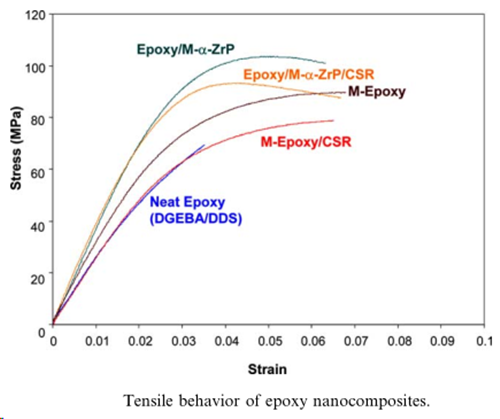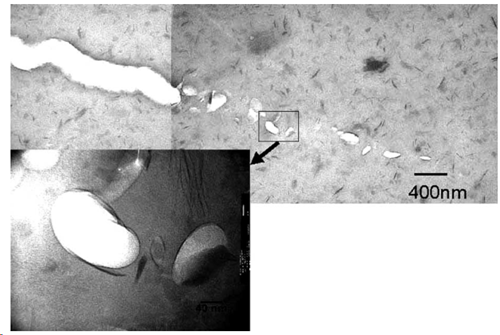Sunshine Factory, Co., Ltd. > Applications > ZrP for PolymerZrP for Polymer
An Epoxy Nanocomposite System With Greatly Improved Modulus, Strength, And Toughness.
Abstract
The size and shape of α-ZrP can be controlled by altering the reaction conditions .the ion exchange capacity of α-ZrP is as much as six times higher than clay.
the surface of α-ZrP can be easily modified by various charge-carrying ionic polymers to achieve compatibilization and exfoliation of α-ZrP in various polymer matrices.
Therefore, α-ZrP particles are ideal for fundamental study of nanofiller effects, in-cluding the effects of aspect ratio, size, and size distribution of the nanofillers, on polymer nanocomposite properties.
the surface of α-ZrP can be easily modified by various charge-carrying ionic polymers to achieve compatibilization and exfoliation of α-ZrP in various polymer matrices.
Therefore, α-ZrP particles are ideal for fundamental study of nanofiller effects, in-cluding the effects of aspect ratio, size, and size distribution of the nanofillers, on polymer nanocomposite properties.
Here, a reduced amount of monoamine- terminated polyether amine was utilized as the surface modifier to achieve exfoliation and dispersion of α-ZrP in epoxy.
Attention will be placed on studying the fracture and toughening mechanisms in both neat and core-shell rubber (CSR) modified α-ZrP based epoxy nanocomposites.
Special attention will be focused on learning how the nanofiller and their surface modifier affect the crack propagation of epoxy matrix. Approaches for achieving a balanced stiffening and toughening effect in epoxy are discussed.
Results and discussion
Tensile behavior
The tensile curves of the epoxy and epoxy nanocom-posites are shown in (Fig.)

The use of monoaminesurface modifier in DGEBA/DDS appears to improve the ductility of the epoxy matrix significantly.

The use of monoaminesurface modifier in DGEBA/DDS appears to improve the ductility of the epoxy matrix significantly.
As expected, α-ZrP nanofiller is effective in enhancing both the tensile strength and modulus of the M-epoxy matrix from 90 to 103 MPa and 3.1 to 4.0 GPa, re-
spectively.
The addition of CSR causes the modulus to drop from 4.0 GPa for epoxy/M-α-ZrP to 3.6 GPa for epoxy/M-α-ZrP/CSR, and from 3.1 GPa for M-epoxy to 2.6 GPa for M-epoxy/CSR.
The tensile strength is also decreased from 103 MPa for epoxy/M-α-ZrP to 93 MPa for epoxy/M-α-ZrP/CSR.
The addition of CSR causes the modulus to drop from 4.0 GPa for epoxy/M-α-ZrP to 3.6 GPa for epoxy/M-α-ZrP/CSR, and from 3.1 GPa for M-epoxy to 2.6 GPa for M-epoxy/CSR.
The tensile strength is also decreased from 103 MPa for epoxy/M-α-ZrP to 93 MPa for epoxy/M-α-ZrP/CSR.
Their key mechanical properties are listed in Table.

When CSR is utilized to toughen epoxy/M-α-ZrP, a significant increase in KIC , i.e., from 0.69 to 1.64 MPa m0.5, is observed. This dramatic increase in fracture toughness by addition of only a small amount of CSR was also observed in epoxy/clay nanocomposites
Toughening mechanisms observation
we can partially attribute the unusual toughening phenomenon to the weak interlayer strength of the intercalated a-ZrP, as evidenced by Figs.
Fig.1.TEM of the crack tip damage zone of epoxy/M-a-ZrP nanocomposite. Delaminated cavities are observed at the crack tip region.

Fig. 2. TEM of crack wake of epoxy/M-a-ZrP nanocomposite. Remnants of delaminated a-ZrP layers (see arrows) are found along the crack wake.

In this case ,this allows the deformation of the matrix prefer-entially along the intercalated M-α-ZrP.
Another interpretation is that the epoxy network is more loosely formed near the α-ZrP particles because of the local high concentration of monoamine surface modifier near α-ZrP, which leads to localized lower crosslink density around α-ZrP in the epoxy matrix.
This, then,helps compensate for the constraint of molecular mobility exerted by the α-ZrP layer structure.
Consequently, the ductility and toughenability of the epoxy/M-a-ZrP is maintained.
Conclusion
The mechanical properties and fracture behavior of synthetic α-ZrP based epoxy nanocomposites, with and without CSR toughening, were investigated. Reasonably good exfoliation and dispersion of α-ZrP was achieved in DGEBA/DDS epoxy matrix.
Exfoliated α-ZrP nanofiller can greatly improve modulus and strength, without compromising the ductility, of the epoxy matrix.
The delamination strength of the intercalated α-ZrP appears to be weak, which leads to preferential delamination, and thus, crack propagation along the
intercalated α-ZrP.
The toughening by incorporation of CSR is found to be effective in improving the KIC of epoxy nanocomposite.
The main toughening mechanisms in epoxy/M-α-ZrP/CSR are rubber particle cavitation, followed by matrix shear banding.
The main cause for such usual improvement in toughness in epoxy/M-α-ZrP is still unclear. It may be either due to the non-uniform crosslinking of the epoxy matrix because of the presence of the monoamine surface modifier around the α-ZrP particles or due to weak delamination strength of the intercalated α-ZrP particles, or both.
Additional research is still needed to fully understand the fundamental reasons behind such an unusual mechanical behavior observed in epoxy/M-α-ZrP and epoxy/M-α-ZrP/CSR systems.
2004 Acta Materialia Inc. Published by Elsevier Ltd. All rights reserved.

Follow WeChat


